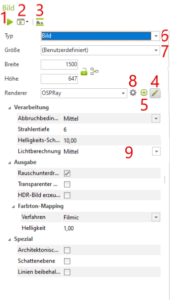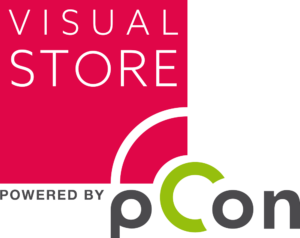Generate image with OSPRay
To render the planning you have created, please go to "Presentation" in the upper tab. There click on the icon for image.
In this area you can make all settings that are important for the rendering, such as: the render quality.
The render window:

- Starts the rendering
- Starts batch rendering
- Displays the area that will be rendered
- Edit render profile
- Create new render profile
- Type setting
- Image
- Panorama
- Multi Content Picture
- Setting the image size
- Renderer selection
- Edit the basic settings
Options:
- Termination condition:
- Here you set at which image quality the render process should stop. For Preview, Medium or High, the calculation stops automatically as soon as the specified quality level is reached. If you set the level to Unlimited, the image calculation continues until you click Stop in the Image dialog.
- Use the Custom selection option to specify your own variance threshold as a termination criterion.
- Variance threshold
- Available for termination condition "User defined". Statistical value as a measure of the remaining noise. The smaller the value (goes towards 0), the more correct the image. We recommend a value of 1.5.
- Beam depth
- Beam depth for path tracing. Specifies how often a light beam is reflected in the scene. It is recommended to keep the preset value (6-8).
- Brightness threshold
- A low value prevents aliasing effects in very strongly illuminated image areas. Low values also reduce the contrast in the image.
- Create HDR image
- The rendering is output as an HDR image (High Dynamic Range Image).
- Hue mapping
- Selection of the method for adjusting the color gamut within an image to match the display capacity of conventional monitors, so that the rendered result appears as natural as possible to the viewer.
- Choose here between Simple, Filmic, Drago and Reinhard. Filmic is the default method. Filmic, Drago as well as Reinhard compress the contrast range in brighter image areas more than in darker image sections. These methods produce more dynamic images compared to Simple.
- Simply filters out all color values from the image that are too bright to be displayed on a conventional monitor.
- Architectural camera
- If this box is unchecked, the default camera is used. The image is calculated in a real perspective. If you check the Architectural camera box, the perspective display is rectified, which means that all vertical edges in the planning are also displayed vertically in the rendering.
- Shadow level
- If you activate this option, a transparent layer is inserted on the zero layer. This creates realistic shadows under single 3D models.
Use this option to create photorealistic images of free-standing products. The image background contains the shadow cast by the imaged object. - It is recommended to set the background to Transparent. Then product images are created, which you can further edit including the shadows in image editing programs and place in other scenes
- We recommend setting the hue mapping to Simple.
- Also, make sure that the product models are level with the zero plane of the world coordinate system.
- If you activate this option, a transparent layer is inserted on the zero layer. This creates realistic shadows under single 3D models.
- Retain lines/lines
- This setting causes that during the photorealistic calculation of an image not only spatial objects and surfaces are considered, but also lines and 2D drawing primitives. These are then visible in the calculated image.
- You can additionally enter a factor via Line width factor by which the line widths are multiplied and thus influence the width of the lines in the print result.
